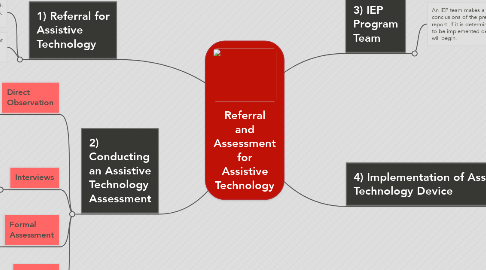
1. 1) Referral for Assistive Technology
1.1. Referral for assistive technology is made by various individuals which includes, but is not limited to: parents, school personnel, physicians, and other referring agencies.
1.2. After a referral is made, a team reviews current and past assessment data to determine if an assessment should take place.
2. 2) Conducting an Assistive Technology Assessment
2.1. Direct Observation
2.1.1. The AT specialist spends time focused on observing the student’s abilities and skills, including the following: Cognitive skills Current use of any AT devices Sensory skills Motor skills Communication skills (Beard, Carpenter, & Johnston, 2011)
2.2. Interviews
2.2.1. Interviews allow the specialist to gather information about specific areas of interest and give parents, teachers, and the student opportunities to express their experiences, interests, and concerns. (Beard, Carpenter, & Johnston, 2011)
2.3. Formal Assessment
2.3.1. A summary of all the information collected during the AT assessment will be the foundation on which to make decisions about whether AT is needed for successful student outcomes. (Beard, Carpenter, & Johnston, 2011)
2.4. Putting it together
2.4.1. After all of the procedures are complete, the AT specialist will construct a comprehensive report on the needs and abilities of the student.
